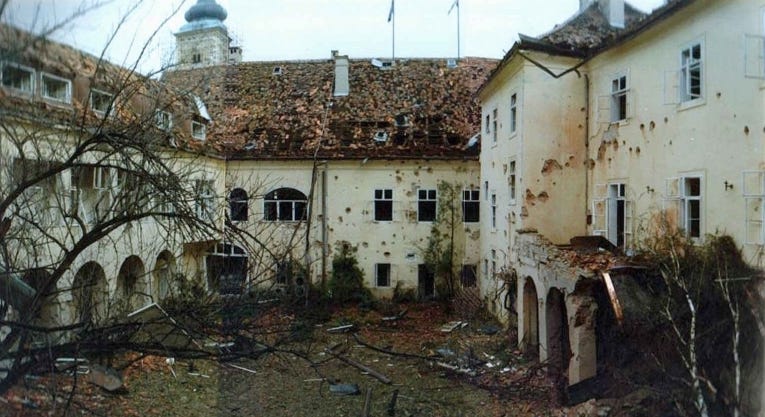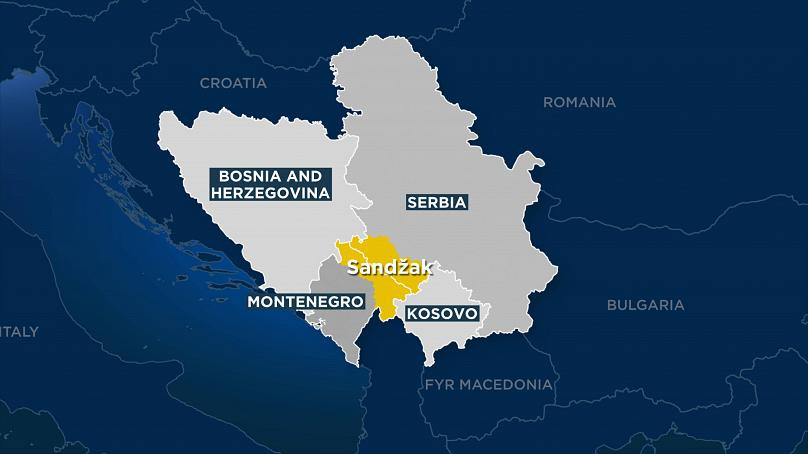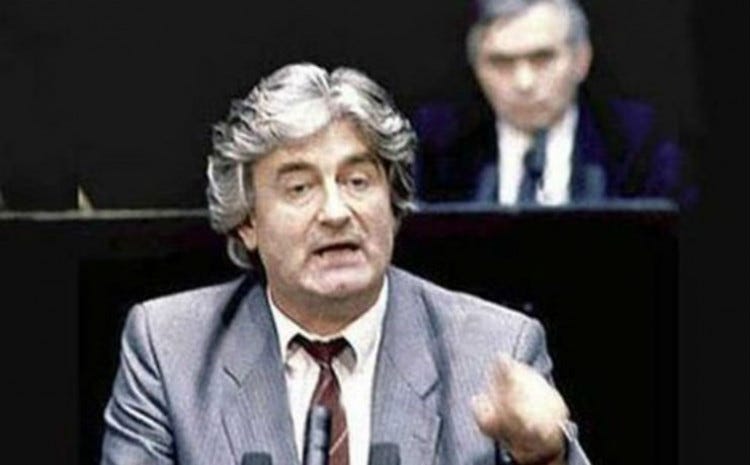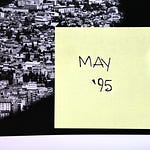It is October 1991.
The Peace Conference on Yugoslavia has begun and the UN Security Council unanimously approved Resolution 713 [you can listen to the latest episode of BarBalkans - Podcast here].
These are two completely counterproductive moves.
In Croatia, the war continues with the dramatic siege of Vukovar and the new war scenarios in Dalmatia.
In Bosnia, the first armed clashes have begun.
Despite the many ceasefires and fake truces, ethnic conflicts spread like wildfire in almost all the Socialist Republics.
Attack on the Palace
For months, the Yugoslav People’s Army (JNA) has been supporting the Greater Serbia project, to unify all Serb-inhabited territories of the former Yugoslavia.
At least since General Veljko Kadijević drew up the RAM Plan.
The attack on Croatia has begun in July and after three months of fighting, all the major population centers are under siege.
Vukovar, in eastern Slavonia. Zadar, Split and Dubrovnik, in Dalmatia.
Zagreb is not so far away, but interest in Croatia’s capital is little. The order for federal soldiers is to converge towards Krajina, Slavonia and Bosnia.
Even if blazing actions are also certainly not despised.
The perfect occasion happens on October 7, the day when the 3-month moratorium sanctioned by the Brioni Agreement expires.
Slovenia reaffirms its independence, having encountered no obstacles since the ten-day war.
Things are different in Croatia, when it breaks all ties with the Socialist Federal Republic.
The Serbian President, Slobodan Milošević, and the JNA High Command decide to teach Croatian President, Franjo Tuđman, a lesson.
Long story short, they organize an attack to his life and try to provoke a massacre in Zagreb.
At 3:04 p.m. on October 7, a Mig launches two missiles at the presidential palace, hitting Tuđman’s office and uncovering the 17th-century roof.
The Croatian President has his life saved, just because shortly before the attack he decided to have a coffee with the President of Yugoslavia, Stipe Mesić, and the federal prime minister, Ante Marković, on the ground floor, after a talk with them.
In his memoirs, Tuđman writes:
«We hold hands until we go out into the street. On the stairs, plaster, pieces of furniture, glass. The huge, ancient entrance door is destroyed. In the courtyard there is a crater, people are fleeing».
The Serbian attack continues with an attempt to provoke an ecological catastrophe. Missiles hit a pharmaceutical factory and other chemical plants.
At the same time, Croats respond with equal cruelty.
Between 16 and 17 October, a massacre take place in Gospić, a town 50 kilometers from Zadar.
A police expedition ends with the kidnapping of 150 ethnic Serbs.
About a hundred of them - some of the town’s most prominent people - are shot. Their bodies are later found in mass graves.
Investigations lead to the ultranationalist members of the Croatian Democratic Union (HDZ). General Mirko Norac and officer Tihomir Orešković will be identified as those responsible for the massacre.
In addition, the Croatian National Guard continues to block the federal barracks, cutting off all supplies.
This decision adds fuel to the fire of war between Belgrade and Zagreb.
The fate of Bosnia, Kosovo and the Sanjak
The echo of these events has a great impact also outside the Croatian borders.
On the wave of Slovenian, Croatian and Macedonian independence, Albanians of Kosovo vote for a resolution on the independence and sovereignty of Kosovo.
On October 19, the Parliament in Pristina declares the birth of the Republic of Kosovo and a provisional government is formed.
The institutional separation is clear. However, the Serbian authorities prefer to tolerate the independence, maintaining their territorial influence limited to certain areas and managing the recolonization by Kosovo Serbs.
Something similar is happening in Sanjak, the historical region between Serbia and Montenegro, with Muslim majority (two thirds of the 500 thousand inhabitants are of Islamic faith).
Between 25 and 27 October, Bosniaks’ political representatives organize a referendum on autonomy.
Both the provisional government of Kosovo and the referendum in Sanjak are declared illegal by Belgrade.
But the most fragile situation is in Bosnia and Herzegovina.
On October 7, the Bosnian President, Alija Izetbegović, proposes a memorandum on the establishment of a «sovereign, democratic and indivisible State» to the Parliament in Sarajevo.
In the new Bosnia and Herzegovina, all its peoples - Muslims, Serbs and Croats - would enjoy the same civil and political rights.
In practice, it is a declaration of independence from the Yugoslav Federation.
The proposal is welcomed by the deputies of the Party of Democratic Action (SDA) and the Croatian Democratic Union (HDZ). The Serb Democratic Party (SDS), on the other hand, is against it.
The memorandum is approved on October 15.
The new government decides to adopt as its national coat of arms the golden lilies on a blue field, the heraldic symbol of the sovereign dynasty of Kotromanić, who made Bosnia great between 1254 and 1463.
It is an attempt to appeal to the common roots of all Bosnians.
But the Serbs of Bosnia’s door is still locked.
The 73 SDS deputies leave the Parliament and express their support for unity with Yugoslavia and the autonomous regions of Krajina and Slavonia during an assembly in Banja Luka.
These are the preconditions to one of the most dramatic ethnic conflicts in recent European history.
The Serbs of Bosnia’s leader, Radovan Karadžić, is one of the major responsible. He is bad poet, a perfect demagogue and an excellent “Butcher”. During a parliamentary session in Sarajevo he casts his curse on the future genocide in Bosnia:
«We must prevent Bosnia and Herzegovina from following the path of Slovenia and Croatia. Be careful of the game you play, because Bosniaks will not be able to defend themselves if they wage war. Your people will perish on the highway to hell».
President Izetbegović comments that «his words and his behaviour explain why no one wants a Yugoslavia like the one Karadžić desires anymore. No one, except perhaps the Serbs».
However, in October it is too late to stop the ethnic hatred in Bosnia.
A hopeless Plan
In the meantime, the European Community (EEC) is still looking for a solution to the crisis in Yugoslavia acceptable to all parties.
The Declaration of intent signed during the Hague Conference lays the foundations for Lord Peter Carrington’s Plan.
Based on the assumption that restoration of the Socialist Federal Republic is not possible, the British diplomat suggests the establishment of a community with a flexible structure.
The basis is a free alliance of sovereign and independent States, which cooperate voluntarily in the economic, fiscal and military fields.
The community would have a legal personality and common institutions, with the possibility of even closer bilateral ties.
It is easy to see a sort of miniature EEC. Or an attempt to push an overly optimistic solution.
The Carrington Plan focuses above all on the protection of minorities. Majority groups in certain areas are granted special political rights and dual citizenship.
All Republics are reluctant to this idea. It is Serbia, however, that sinks the project.
Belgrade explicitly rejects the Carrington Plan, because it claims it cannot tolerate Yugoslavia being wiped out with a signature.
In the Balkans, the issue is about identity conflicts in territories considered to be “exclusive property” of a single people or ethnic group.
Compromise is not an option.
Indeed, the war never stops. Ceasefires are ineffective.
Dubrovnik is surrounded by the Federal Army by both land and sea. The Dalmatian towns are all under JNA fire.
Vukovar becomes a new Stalingrad, while the population desperately tries to resist the Serbian siege.
The city is now without water and electricity. It is hit by over 5 thousand bullets a day and relies only on supplies parachuted by Zagreb’s military planes.
Actually, the Croatian Army would have the opportunity to break the siege and free the city. But, all of a sudden, President Tuđman orders to stop the military action.
It is not clear why. Perhaps to give time to the NGO Doctors Without Borders to evacuate wounded people from Vukovar. Or perhaps because of strategic incapacity.
The fact is that the JNA takes advantage of the chance to surround the city once again.
This is the beginning of the end for Vukovar. The fate of the Wolf Fortress is now sealed.
If you liked this article, you can spread this parallel journey and the free weekly newsletter on social media:
You can also give a gift subscription to whoever you want. Don’t let this virtual trip to the Balkans get lost!
Here is the archive of BarBalkans - Podcast:




















Share this post